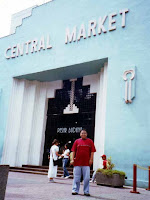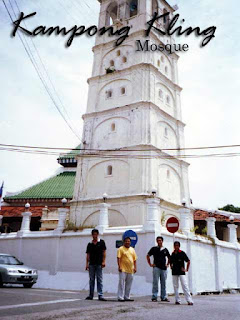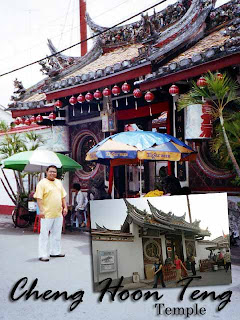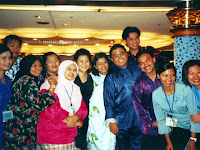After visiting Georgetown in Penang, Malaysia, Ivan Man Dy explores Melaka, both of which are included in the UNESCO World Heritage inscription. Text and photos by Ivan Man Dy.
Melaka (Malacca), they say, is where Malaysia began. Founded in the 1400s this city can certainly claim historical pedigree more than any other in Malaysia. Its long list of narratives include Malay sultanates, Chinese migration, Portuguese, Dutch, British and Japanese occupations.
Similar to its northern sister city, Georgetown, Melaka boast of a multicultural legacy brought about by these currents of history. However, unlike the former, Melaka's historic center is noticeably smaller and in fact, may well just be zipped through for the obligatory photo opportunity as I noticed with a lot of day tour packages.
Not for me though. As a heritage junkie, historic towns like this appeal to me a lot and I opted to stay overnight.
The thing with Melaka is that the historic center is actually small enough and everything can be covered by foot. At the center of it is the red-colored Dutch Square whose landmarks include Christ Church (1753), the oldest Protestant church in Malaysia, and the Stadthuys, former residence and headquarters of the colonial Dutch governors, which today houses the Museum of History and Ethnography. This is where the trigger happy tourists let loose and it's interesting that just a few steps up (and RM10 entrance fee) will lead you to a fascinating and quiet crash course on the city's rich narrative.
At the back of the the Stadhuys is St. Paul's Hill where stands the ruins of Portuguese-built St. Paul's Church (1521). Inside are some old European tombstones as well as the temporary burial spot of the Catholic Jesuit St. Francis Xavier before his remains was transferred to Goa.
Also in the area is the A Famosa, the only remant of Melaka's original Portuguese fortifications. To further highlight this 130 odd years of Portuguese occupation, parts of the original city walls have been excavated and rebuilt. Think a super mini version of Manila's Intramuros walls.
End your walk of the area at English-colonial style Proclamation of Independence Memorial Hall, where the first prime minister Tunku Abdul Rahman announced the country's independence from Britain in 1957.
The history of Melaka has always been tied up with trading and the Melaka River certainly played a very big part in it. Take a stroll at the refurbished river promenade before heading on Chinatown across the river. Located on the three major streets (which are all parallel each other) very close the Dutch Square, this is perhaps the liveliest part of the old town. Lined with traditional shop houses that still function in their original purpose, they range from simple to really ornate.
Jalan Tokong is home to three places of worship: the Taoist Cheng Hoon Teng Temple (1645),the Hindu Sri Poyyatha Vinayagar Moorthi Temple (1785) and Islamic Kampong Kling Mosque (1868). The former two lay claim to the oldest in the country. And of course, a cliche we often heard in Malaysia, Jalan Tokong is a known as the 'Street of Harmony'.
Over at Jalan Tun Tan Cheng Lock, don't miss the charming Baba Nyonya Museum for an insight on the lives of the culturally-rich Peranakan Cina (Chinese-Malay) community. And if you are so really historically-inclined, walk about 25 minutes from the Dutch Square to Bukit Cina (Chinese Hill), supposedly the largest Chinese cemetery outside China. Huff and puff your way up to view the burial mounds or light an incense at Sam Poh Kong. This temple is said to have links with the legendary Ming Dynasty explorer Cheng Ho, another of Melaka's great touchstones in her fabled history.
So much history, all captured within one overnight stay. Definitely worth the sleep.
Showing posts with label Malacca. Show all posts
Showing posts with label Malacca. Show all posts
Sunday, May 27, 2012
Saturday, November 28, 2009
Malaysia: Malacca's Perenakan (Nyonya) cuisine
 Malacca also has it's share of Perenakan cuisine. So before I move on to a different topic, let's continue our discussion on Malaysian food. While we were in Malacca, we had lunch at a Nyonya restaurant called Seroni Nyonya Cuisine Restaurant.
Malacca also has it's share of Perenakan cuisine. So before I move on to a different topic, let's continue our discussion on Malaysian food. While we were in Malacca, we had lunch at a Nyonya restaurant called Seroni Nyonya Cuisine Restaurant.We were served a really sumptuous selection of Nyonya cuisine that included chicken tempra, fish fillet with tamarind sauce, anchovies with cili garam, ginger venison (deer), fried kampung rice, lemak prawns and stir fried okra. For dessert, we were given yummy bowls of cendol.
 While we did our walking tour around Jonker Street later in the afternoon, I also got to try out some of the goodies. There was a shop which sold pastries with pineapple filling as well as winter melon cakes (a.k.a. hopia). Along the street were a good number of hawker stalls which sold siomai, baked siew pau, radish and yam cakes, dried fish and squid, and other local stuff.
While we did our walking tour around Jonker Street later in the afternoon, I also got to try out some of the goodies. There was a shop which sold pastries with pineapple filling as well as winter melon cakes (a.k.a. hopia). Along the street were a good number of hawker stalls which sold siomai, baked siew pau, radish and yam cakes, dried fish and squid, and other local stuff.It's sad that the chicken rice balls restaurant was closed by the time we arrived. It's really in-demand so it gets sold out easily and they close shortly after lunch. In Malacca, Hainanese chicken rice was modified so that the chicken is served with rice balls rather than a bowl of rice.
Part 1: Melaka, Malaysia is a historic city of the Straits of Malacca
Related entries
More Straits Settlements history in Malacca
Exploring the Penang heritage trail on foot
Bus trip from Kuala Lumpur to Penang, Malaysia
Following the heritage trail in Penang
Seroni Nyonya Cuisine Restaurant
60 & 62 Taman Melaka Raja 1, Jalan Melaka Raya 24, Melaka
Telephone: +60 (6) 2814848
Monday, September 21, 2009
Malaysia: Melaka, Malaysia is a historic city of the Straits of Malacca
 Melaka or Malacca was inscribed in the UNESCO World Heritage List last year together with George Town as the Historic Cities of the Straits of Malacca. So I was elated Tourism Malaysia brought us to Melaka for this trip since it's been quite a while since I last visited.
Melaka or Malacca was inscribed in the UNESCO World Heritage List last year together with George Town as the Historic Cities of the Straits of Malacca. So I was elated Tourism Malaysia brought us to Melaka for this trip since it's been quite a while since I last visited.I'd been here several times before but just like George Town in Penang (which I got to visit just a month before), it's nice to visit after it's been declared a UNESCO World Heritage Site. We made the rounds of the historical sites and had the local Nyonya food for lunch.
According to UNESCO, "Melaka and George Town, historic cities of the Straits of Malacca have developed over 500 years of trading and cultural exchanges between East and West in the Straits of Malacca. The influences of Asia and Europe have endowed the towns with a specific multicultural heritage that is both tangible and intangible. With its government buildings, churches, squares and fortifications, Melaka demonstrates the early stages of this history originating in the 15th-century Malay sultanate and the Portuguese and Dutch periods beginning in the early 16th century. Featuring residential and commercial buildings, George Town represents the British era from the end of the 18th century. The two towns constitute a unique architectural and cultural townscape without parallel anywhere in East and Southeast Asia."
 Our first stop before entering the historic core of Melaka was the Bukit Cina Cemetery which is located in Bukit Cina and two adjoining hills. This Chinese graveyard covers over 250,000 square meters and with over 12,000 graves, some of which date to the Ming Dynasty, is said to be the largest Chinese cemetery outside China.
Our first stop before entering the historic core of Melaka was the Bukit Cina Cemetery which is located in Bukit Cina and two adjoining hills. This Chinese graveyard covers over 250,000 square meters and with over 12,000 graves, some of which date to the Ming Dynasty, is said to be the largest Chinese cemetery outside China.Another popular stop entering old Melaka is Sam Po Kong Temple. But since we didn't have much time, we skipped this one. A popular attraction beside the temple is Hang Li Po's Well. They say anyone who throws a coin into the well will return to Melaka. I did the last time, and look who's back!
 At the center of old Malacca is Stadthuys, said to be the oldest Dutch building in the east, a town hall built by the Dutch in 1650 to house the office of the Dutch Governor and Deputy Governors. The square, which is also known as Red Square because it is surrounded by port-red structures that also include a clock tower and Christ Church.
At the center of old Malacca is Stadthuys, said to be the oldest Dutch building in the east, a town hall built by the Dutch in 1650 to house the office of the Dutch Governor and Deputy Governors. The square, which is also known as Red Square because it is surrounded by port-red structures that also include a clock tower and Christ Church.Christ Church was completed in 1753. Inside this Dutch church are 200-year old pews, an altar painting of the Last Supper on glazed tiles, as well as 15-meter beams each made from a single tree.
 From there, we walked up the hill towards the ruins of the St. Paul Church. A statue of St. Francis Xavier stands in front of the ruins, a reminder that the saint was temporarily buried here in 1553 before being transported to Goa. In fact, the open grave where he was buried is still at the back of the church.
From there, we walked up the hill towards the ruins of the St. Paul Church. A statue of St. Francis Xavier stands in front of the ruins, a reminder that the saint was temporarily buried here in 1553 before being transported to Goa. In fact, the open grave where he was buried is still at the back of the church. Down the hill, on the other side, is the Porta de Santiago, the only part of the Kota A Famosa left standing. The Portuguese had originally built this fort in the early 1500s. It became a Dutch fort in 1641, and was later handed over to the British in the early 19th century. Wary of maintaining fortifications, the British ordered its destruction in 1806. But thanks to a timely visit and intervention of Sir Stamford Raffles who had a passion for history, this gate was spared.
Down the hill, on the other side, is the Porta de Santiago, the only part of the Kota A Famosa left standing. The Portuguese had originally built this fort in the early 1500s. It became a Dutch fort in 1641, and was later handed over to the British in the early 19th century. Wary of maintaining fortifications, the British ordered its destruction in 1806. But thanks to a timely visit and intervention of Sir Stamford Raffles who had a passion for history, this gate was spared.When it comes to food, don't miss the Nyonya cuisine which is unique to Melaka/Malacca. The Baba-Nyonya are the Straits Chinese, descendants of very early Chinese immigrants who partially adopted Malay customs. Another collective term for these immigrants is Peranakan which refers to descendants of foreigners who had assimilated into the local community. There are Indian Peranakans called Chitty and Eurasian Peranakans known as Kristang. In the Philippines, we had the Mestizos de Sangley, with Tsinoy as its modern day equivalent.
 We had lunch at Seroni Nyonya Cuisine Restaurant (more on this in another post) before exploring more of the historic core. We visited the Kampung Kling Mosque and the Cheng Hoon Teng Temple in Jalan Tokong before shopping at Jonker Street.
We had lunch at Seroni Nyonya Cuisine Restaurant (more on this in another post) before exploring more of the historic core. We visited the Kampung Kling Mosque and the Cheng Hoon Teng Temple in Jalan Tokong before shopping at Jonker Street.The Kampung Kling Mosque sometimes spelled Kampung Keling, was built by Indian Muslim traders in the 18th century.
Along Jalan Tokong, notice the traditional craft shops which include those large paper figurines they burn during funerals as well as the beaded-slippers which cost at least RM700 per pair!
 The Cheng Hoon Teng Temple, also along Jalan Tokong is the oldest functioning temple in Malaysia. While primarily a Buddhist temple, the temple complex is also said to host prayer quarters dedicated to Taoist and Confucian practices. The main prayer hall is dedicated to Kuan Yin. While additional smaller prayer quarters added later were dedicated to the Taoist gods of wealth, longevity and propagation and ancestral tablets.
The Cheng Hoon Teng Temple, also along Jalan Tokong is the oldest functioning temple in Malaysia. While primarily a Buddhist temple, the temple complex is also said to host prayer quarters dedicated to Taoist and Confucian practices. The main prayer hall is dedicated to Kuan Yin. While additional smaller prayer quarters added later were dedicated to the Taoist gods of wealth, longevity and propagation and ancestral tablets.
 Jonker Street or Jalan Hang Jebat is a cluster of shops and other old structures that currently houses restaurants, art galleries, antique and souvenir shops, as well as traders of traditional items: goldsmiths, watch repairers, clog makers and beaded shoemakers, blacksmiths, rattan and bamboo weavers, Chinese traditional medicine merchants and food outlets.
Jonker Street or Jalan Hang Jebat is a cluster of shops and other old structures that currently houses restaurants, art galleries, antique and souvenir shops, as well as traders of traditional items: goldsmiths, watch repairers, clog makers and beaded shoemakers, blacksmiths, rattan and bamboo weavers, Chinese traditional medicine merchants and food outlets.If only I wasn't so full, I would have tried a little bit of everything the hawkers along Jonker Street were selling. The street food really looked good, and I'm sure it tasted good too!
We drove back to Kuala Lumpur at about 4 p.m. and since it was a free night, I decided to get some rest for the fun planned for our visit to Genting Highlands.
Friday, January 05, 2007
Malaysia: More Straits Settlements history in Malacca
 I arrived in Kuala Lumpur from Penang late in the evening. Of course, the first thing we did was go for a late dinner. If I remember it right, it was at a mamak which served roti canai, beef murtabak and teh tarik.
I arrived in Kuala Lumpur from Penang late in the evening. Of course, the first thing we did was go for a late dinner. If I remember it right, it was at a mamak which served roti canai, beef murtabak and teh tarik.September 19: The next day, I think we went shopping since the only thing I could remember was that we passed by KL's Central Market. That evening too, Leon took a bus from Singapore to join us in KL.
 September 20: We decided to go to Malacca (Melaka) and meet up with Shyamala, another SSEAYP batchmate who lived there. Aside from me, Kenneth and Leon, two Filipino friends of Kenneth joined us.
September 20: We decided to go to Malacca (Melaka) and meet up with Shyamala, another SSEAYP batchmate who lived there. Aside from me, Kenneth and Leon, two Filipino friends of Kenneth joined us.Since I had been to Malacca the previous year during the SSEAYP program, we didn't go around much. I hadn't realized it then but I had actually visited the three major towns of the Straits Settlements (Singapore, Penang and Malacca) during the trip.
 Just like Penang, Malacca had its own heritage trail sponsored too by American Express. We started at the Town Center of Malacca Town. One of the major structures there is Stadthuys. which according to the Melaka website was built in 1650 as the official residence of Dutch Governors and Deputy Governors. It adds that "the edifice is a fine example of Dutch architecture, with solid doors and louvred windows. Believed to be the oldest Dutch building in the East, the port-red theme extends to the other buildings around the Town Square and the old clock tower."
Just like Penang, Malacca had its own heritage trail sponsored too by American Express. We started at the Town Center of Malacca Town. One of the major structures there is Stadthuys. which according to the Melaka website was built in 1650 as the official residence of Dutch Governors and Deputy Governors. It adds that "the edifice is a fine example of Dutch architecture, with solid doors and louvred windows. Believed to be the oldest Dutch building in the East, the port-red theme extends to the other buildings around the Town Square and the old clock tower."Also painted in port-red is Christ Church which was completed in 1753. Inside this Dutch church are 200-year old pews, an altar painting of the Last Supper on glazed tiles, as well as 15-meter beams each made from a single tree.
 From the Town Center, we walked straight to Jonker Street (Jalan Hang Jebat) which is a cluster of art galleries, antique and souvenir shops, as well as traders of traditional items, "among them goldsmiths, watch repairers, clog makers and beaded shoemakers, blacksmiths, rattan and bamboo weavers, Chinese traditional medicine merchants and food outlets."
From the Town Center, we walked straight to Jonker Street (Jalan Hang Jebat) which is a cluster of art galleries, antique and souvenir shops, as well as traders of traditional items, "among them goldsmiths, watch repairers, clog makers and beaded shoemakers, blacksmiths, rattan and bamboo weavers, Chinese traditional medicine merchants and food outlets." Also in the area were several mosques and temples, among them the Kampong Kling Mosque, one of the oldests mosques in Malaysia which has Sumatran architectural features; and the Cheng Hoon Teng Temple which was built in 1646 and is thus the oldest Chinese temple in Malaysia.
Also in the area were several mosques and temples, among them the Kampong Kling Mosque, one of the oldests mosques in Malaysia which has Sumatran architectural features; and the Cheng Hoon Teng Temple which was built in 1646 and is thus the oldest Chinese temple in Malaysia.One of the must see sights which I got to visit the previous year is A'Famosa, the "hallmark of Melaka and perhaps the most photographed subject next to the Stadthuys. Built by the Portuguese in 1511 as a fortress it sustained severe structural damage during the Dutch Invasion. The British had set to destroy it but timely intervention by Sir Stamford Raffles in 1808 saved what remains of A' Famosa today."
 Also visit the ruins of St. Paul's Church, where the remains of St. Francis Xavier were briefly enshrined in the open grave in 1553 before they were brought to Goa, India.
Also visit the ruins of St. Paul's Church, where the remains of St. Francis Xavier were briefly enshrined in the open grave in 1553 before they were brought to Goa, India.When it comes to food, don't miss the Baba-Nyonya cuisine which is unique to Malacca. The Baba-Nyonya are the Straits Chinese, descendants of very early Chinese immigrants who partially adopted Malay customs. Another collective term for these immigrants is Peranakan which refers to descendants of foreigners who had assimilated into the local community. There are Indian Peranakans called Chitty and Eurasian Peranakans known as Kristang. In the Philippines, we had the mestizos de Sangley, with Tsinoy as its modern day equivalent
 After that long day in Malacca, Shyamala joined us back to KL where we met up with another batchmate Andrea. The five of us went up to Genting Highlands for the evening. It is a 2000-meter high peak which is occupied by a mountain resort called Genting - City of Entertainment. They call it the Las Vegas of Malaysia since it is the only legal land-based casino in Malaysia. Aside from the casinos complex and the world-class hotels, other facilities in this resort include a theme park, golf course, shopping malls, sky diving simulator, concert hall and many more
After that long day in Malacca, Shyamala joined us back to KL where we met up with another batchmate Andrea. The five of us went up to Genting Highlands for the evening. It is a 2000-meter high peak which is occupied by a mountain resort called Genting - City of Entertainment. They call it the Las Vegas of Malaysia since it is the only legal land-based casino in Malaysia. Aside from the casinos complex and the world-class hotels, other facilities in this resort include a theme park, golf course, shopping malls, sky diving simulator, concert hall and many moreSeptember 21: It was a Sunday and we didn't do much. Leon had to commute back to Singapore since he had work on Monday. All I remember was we just kept on eating, and eating, and eating since Kenneth was very eager to let me try as much Malaysian hawker food as possible.
 September 22: The M/S Nippon Maru docked in Port Klang. I attended the welcome ceremonies in the afternoon as well as the reception on board the ship in the evening. I had to leave immediately after the reception since I had to rush back to KL which was about an hour away to catch the 11:50 p.m. bus back to Singapore.
September 22: The M/S Nippon Maru docked in Port Klang. I attended the welcome ceremonies in the afternoon as well as the reception on board the ship in the evening. I had to leave immediately after the reception since I had to rush back to KL which was about an hour away to catch the 11:50 p.m. bus back to Singapore.Septermber 23: I arrived in Singapore early in the morning. I think I took a nap after breakfast. I was in Changi Airport by early afternoon for my Singapore Airlines flight back to Manila.
Related entries
Melaka, Malaysia is a historic city of the Straits of Malacca
Exploring the Penang heritage trail on foot
Bus trip from Kuala Lumpur to Penang, Malaysia
Following the heritage trail in Penang
Subscribe to:
Posts (Atom)









